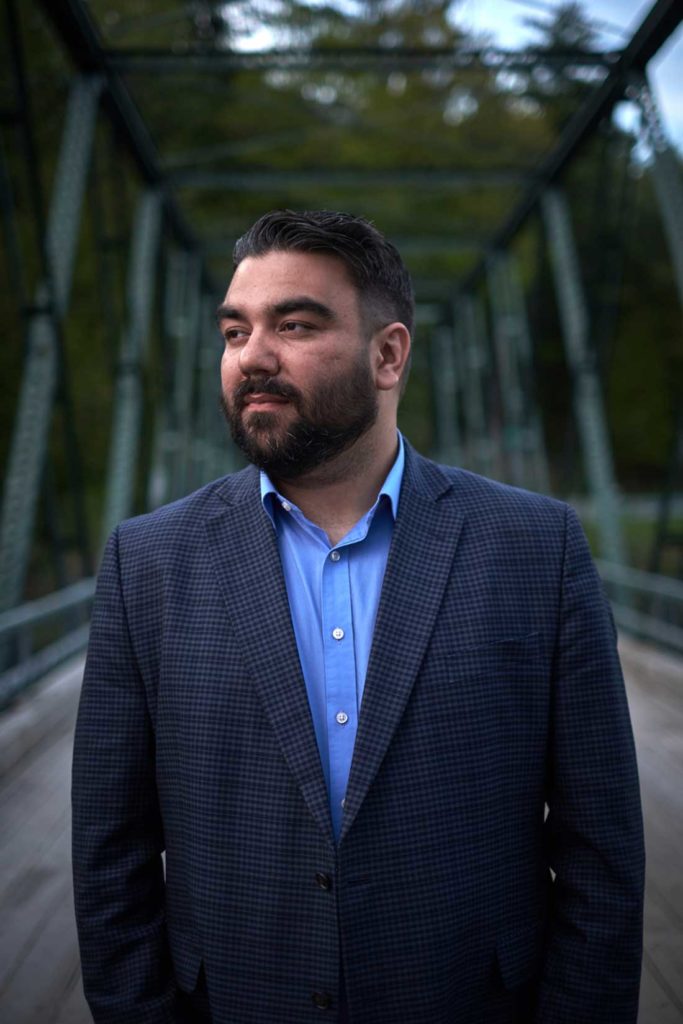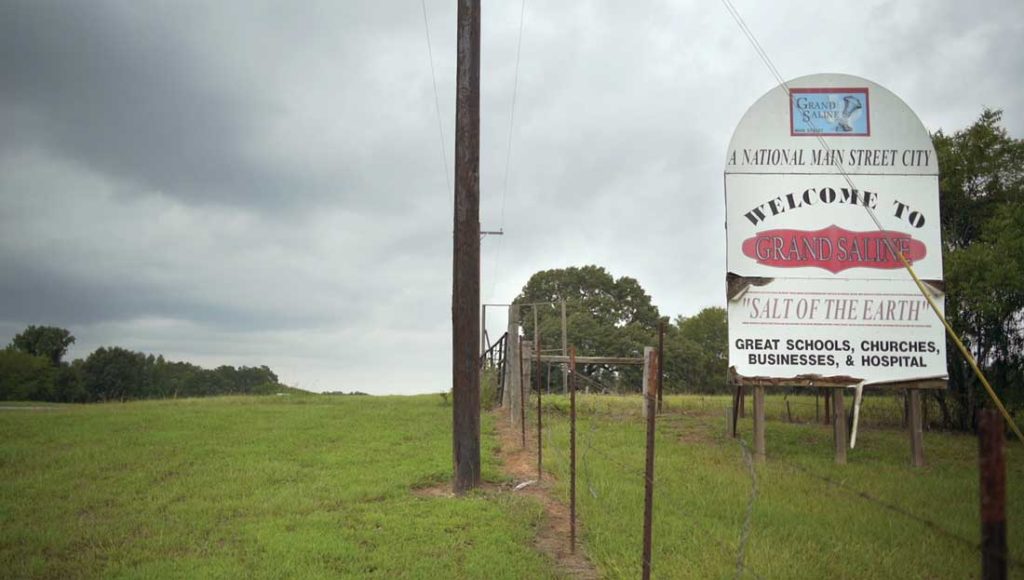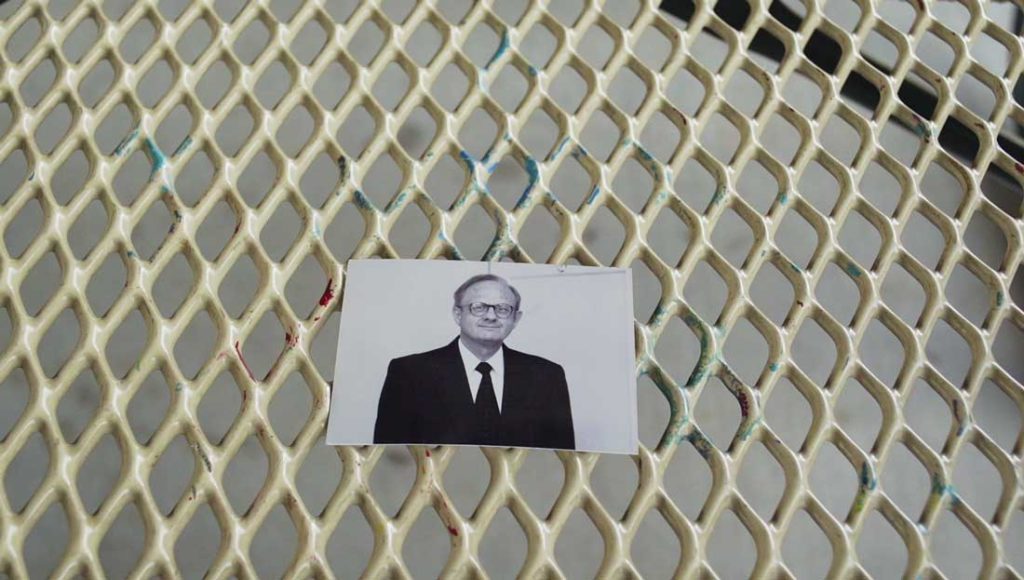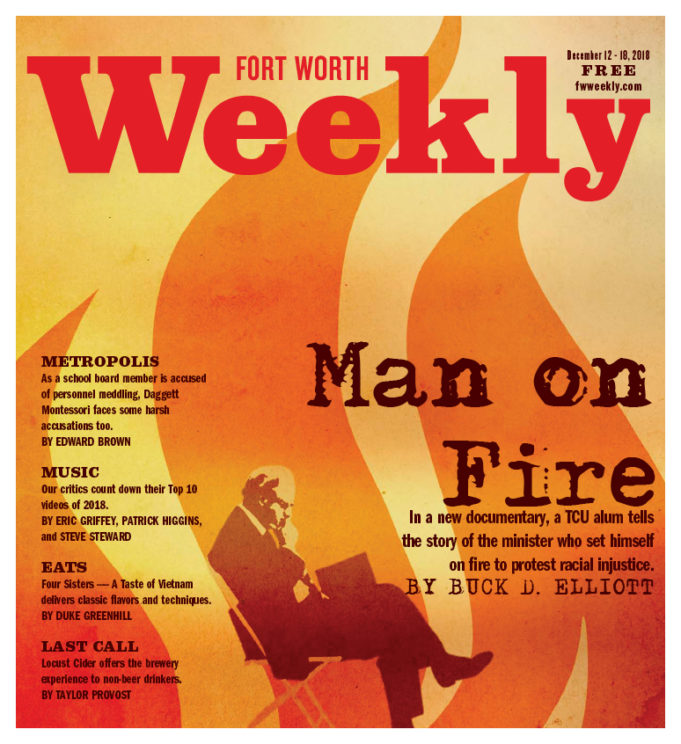On Monday, June 23, 2014, retired Methodist minister Charles Moore drove from his house in Allen, Texas, to Grand Saline, where he parked at the Dollar General. The 79-year-old knelt on a cushion, covered his body in gasoline, and set himself ablaze. Now Man on Fire, a new documentary about Moore, Grand Saline, and a shadowy history of white supremacy premieres Monday on PBS to a national audience. Dr. James Chase Sanchez, former resident of Grand Saline and a doctoral graduate of TCU, co-produced the work whose story was the basis for his dissertation and a book project.
Rev. Moore, one of the subjects of Man on Fire, was born in Grand Saline in 1934. The Methodist minister attended Tyler Junior College and Southern Methodist University, where he earned his bachelor’s of divinity. He led congregations in Texas throughout his life and worked as a missionary abroad as well. Some would call Moore a social justice warrior and others an overzealous agitator. Either way, most everyone he encountered would agree that his ministering and life were centered on the ethical treatment of disenfranchised peoples and protesting injustice.
Head east on 1-20 toward the dingy dive bars of Shreveport, Louisiana, and you’ll scamper quickly past Dallas before a long and piney road through the woods of East Texas. Nestled in those farmlands are many towns with small populations and unmistakable charm. Among trailers and barbed wire lies Grand Saline, also known as the “Great Salt,” a city of 3,100 residents between Wills Point and Mineola on Hwy. 80. Driving through Grand Saline won’t raise an eyebrow for the average North Texas dweller on their way to or through East Texas. Meet the friendly folk and promenade on an unremarkable main street while thinking how much simpler and safer life would be in towns such as these. Visit the Salt Palace Museum and lick the salt wall –– though Yelp suggests otherwise. Salt is essential to Grand Saline and its history. The nearby salt flats were first utilized by Caddo Indians as a trading commodity and have been an essential part of the economy since the town’s inception. Confederate forces considered this salt so valuable that the area was among the most fortified in Texas during the Civil War. Salt, historically, preserves food and animal hides. Preservation is a recurring theme for Grand Saline and what Moore said was the most disturbing thing about it: abject racism and the continuation of an all-white culture.
*****

Sanchez also grew up in Grand Saline. He moved there in seventh grade from the nearby smaller town of Alba. Curiously, Sanchez was partially inspired to relocate after watching the MTV documentary program True Life: I’m a Football Hero, which prominently featured the Grand Saline High School Indians during an undefeated football season in 2000.
“I was given a choice of three different places to move, but I was always attracted to that team,” Sanchez said, “partially because they had always spanked Alba when they played.”
However, Sanchez also said that the racist culture of Grand Saline overwhelmed the aspiring football player immediately.
“During practice, a football coach told us not to piss off black kids on the other team because black kids become better athletes when they’re mad,” Sanchez recalled.
Three significant stories about his new town resonate with Sanchez to this day. Regular Klan activity was commonplace and the hate group held open recruitment during Canton trade days, a popular swap meet and flea market that draws thousands to the area. Signs were said to exist at each edge of town warning African-Americans, “Don’t let the sun set on your black ass.” Rumors were also repeated that blacks were lynched from a nearby bridge suspended over train tracks, allowing their bodies to be demolished by the freight cars and their severed heads placed on poles south of town, though the single documented case of a severed head placed on a pole in Grand Saline is attributable to a white doctor who regularly saw and treated black patients.
“There were all these stories when I was in school, these racist stories, and this racist legacy has existed for a long time,” Sanchez said.
These pieces of lore piqued his interest immediately and stuck in his psyche as he completed his English literature undergraduate and master’s degrees at the University of Texas at Tyler. Then his interest in the dynamics of racism and racial rhetoric expanded throughout his education. Two years into his doctoral program at TCU, Sanchez saw his interest in protest and racial rhetoric become more than academic when Moore self-immolated. Sanchez returned to his Fort Worth home off Trail Lake Drive after teaching summer school on June 23, 2014. Wasting time on social media, he first learned of the self-immolation from a few Facebook posts from people around Grand Saline. He also described the early social media post from a resident who had been at the scene and incorrectly read a letter that Moore left tucked under his windshield wiper.
“The first thing I heard was later that night,” Sanchez said. “Someone that was at the scene read over his letter. Obviously, they were in shock and didn’t read it carefully because the first rumor around Grand Saline was that this guy was a former member of the KKK and was asking for forgiveness.”
That Facebook post incorrectly attributing the reason of Moore’s suicide was removed after the deceased’s family threatened a lawsuit.
Eyewitnesses of Moore’s self-immolation rushed to help in confusion and desperation. Bystanders used a fire extinguisher to suffocate the flame and called for medical support. Moore was taken by helicopter to Parkland Hospital in Dallas, charred but alive, though he would eventually succumb to his self-inflicted burns.
In Moore’s actual letter, he explicitly named the reasons for his actions: After saying he had been shunned from preaching at the Methodist church in town because of his agreement with Brown v. Board of Education, he lamented past KKK activity in Grand Saline and boasts by residents about the killing of “negros.” The note ended with his disillusionment with growing racism and lack of repentance for past atrocities against African-Americans by the country at large but especially his hometown. The date of his immolation was not coincidental, but purposeful, to commemorate the 50th anniversary of Freedom Summer and the murder of three civil rights activists in Philadelphia, Mississippi.
A man committing suicide in a such a painful way – for a selfless reason – should have made instant national headlines. Grand Saline, as well as the rest of East Texas, seemed content to act as if the actions were the cries of a desperate or mentally deranged man, Sanchez believes. Mainstream knowledge of the story was scant. Sanchez used his contacts at the Grand Saline Sun to obtain Moore’s suicide letter two days after the self-immolation.
“It was instant,” Sanchez said. “I knew I had to tell this story. That there was no one else who studied protests, race, and this being my hometown, there would be no one who would have this unique angle to tell the story of Charles Moore.”
*****

The Grand Saline Sun ran one piece a few days after Moore’s death, didn’t mention his name, and gave no specifics about his letter, with only a shrouded and cryptic mention of the motive.
“To me, that was bullshit,” Sanchez said. “That piece told the entire town that his death was about racism without actually telling.”
Sanchez, still a student at the time, took the initiative to contact several news agencies and lobby for coverage of the reverend’s self-immolation. The Tyler Morning Telegraph reached out to Sanchez and ran the first piece referencing Moore in detail and publicly published the windshield letter. The piece, titled “Madman or Martyr,” ran on July 1, 2014. Sanchez felt a sense of responsibility to gather attention for and retell the story. The United Methodist News then published a biography of Moore, followed by The Dallas Morning News, which Sanchez credits with being more sympathetic to a man who’d made a convicted and measured decision to set himself on fire. But Sanchez was disappointed in the earliest coverage.
“They were in it for the shock value, in it for the clicks and were more exploitative,” he said.
The Washington Post ran a short story on Moore almost a month post-mortem. Sanchez believes it had potential for extensive national clout had Grand Saline been more forthcoming initially with details and coverage.
Since at the time Sanchez had been developing the focus of his dissertation – with an emphasis on social protest – he queried his dissertation director, Dr. Brad Lucas, now Director of English Graduate Studies at TCU, to see if the self-immolating reverend would make an appropriate chapter. Sanchez chuckled as he recounted Lucas’ response that it should become the entire dissertation. Sanchez’ research up to the time of Moore’s suicide focused on Mahatma Gandhi and Cesar Chavez and their respective hunger strikes and also, most appropriately, Thich Quang Duc, the Vietnamese Buddhist Monk who self-immolated at a busy intersection in Saigon to protest the treatment of Buddhists by the South Vietnamese government in the mid-1960s. The images of Duc’s immolation are extremely famous, and the photographer, Malcolm Browne, was awarded a Pulitzer Prize for the pictures.
“I was intrigued by protests and violence and the way these shape people,” Sanchez said. “I was also already writing a lot about race, and racism was a sole interest of mine.”
A documentary wasn’t in the original plan for Sanchez. He knew the story had gravity, but his expertise in academia lent to crafting his dissertation and writing a book based on that research, a book that Sanchez is currently working on at his new position as an assistant professor of writing at Middlebury College in Vermont. Still, it’s not surprising that his university website profile photo is lifted from his time producing Man on Fire.
*****

The impact of film and a documentary intrigued Sanchez, but he was stymied by the actual scope of film production. An instructor at TCU suggested that he reach out to a man in Austin who lived below her boyfriend and directed independent films focusing on cultural phenomena. Sanchez reached out to the man, Joel Fendelman, in November 2015. Forever the academic, Sanchez did his homework on Fendelman and was impressed by his previous films with cultural emphasis. “I knew that he could tackle these difficult subjects and that he could handle this very well,” Sanchez said.
A documentary is no small project for any doctoral student who is searching for a professorship, teaching, and dissertating. Sanchez was advised that the workload was massive and production of a film might better be left for after graduation. Undeterred, he took seven trips to Grand Saline to gather footage and interviews to retell the story of the town and what would become its most famous man, on fire. It wasn’t clear how the former football player would be received in a community that obviously wasn’t excited to advertise the events of 2014 to outsiders beyond the pine curtain.
The documentary focuses on the people of Grand Saline, in their own words. Voiceovers are absent. The subjects interviewed tell the town’s stories and of their experiences with the late reverend. Gathering participants proved difficult for Sanchez and Fendelman as they worked through those who knew Moore personally as well as local business owners and government workers.
Many declined interviews. Sanchez admitted that younger people with social media presences were more hesitant to talk to him, knowing that he cared deeply about racial rhetoric from following him on Facebook or Instagram. The members of the production team were akin to private detectives as they tracked down residents who’d previously committed to meet but flaked, many ducking and dodging from multiple meetings, some going as far as avoiding their homes to flee the filmmakers. Information seekers about Moore’s story haven’t fared well either. A Texas Monthly reporter told Sanchez he really couldn’t get anyone to talk to him.
The older folks were more willing to chat, Sanchez said. His status as a former resident seemed to be detrimental for talking with those under 40 but aided in coaxing the older crowd. Some remembered him as a budding football standout with the Indians or even recalled his number or games he’d played in.
Sanchez and Fendelman made a concerted effort to present a balanced view of the “Great Salt” through their wide-lens shots, lack of political commentary, and focus on the interviewees speaking for themselves. Sanchez assumes many will fear that the documentary is a Michael Moore-style hit piece. He and Fendelman even omitted some footage when their subjects would spew objectively racist viewpoints, leading to some interesting conversations during post-production editing.
The subject matter and reputation of Grand Saline could easily lead one to vilify the town in Man on Fire, but Sanchez is adamant that isn’t his objective at all. He wants dialogue and growth for a town that has seemed to double down their efforts to preserve the way things used to be. We talked briefly about the Southlake social media scandal when high school students from the affluent suburb filmed themselves chanting racial slurs. The racial rhetoric scholar was pleased by Southlake’s government officials holding a town hall to engage its citizens in conversations about race. Just the willingness to engage is an encouraging start, Sanchez feels, and this is exactly what he hopes the film will do: that embers from Moore’s end-of-life fire spark participation in honest conversation about the town then and now.
Man on Fire has premiered to select audiences at college campuses and film festivals, though few Grand Saline residents have seen it. Interviewees were invited to view the documentary when it showed at UT-Tyler, but Sanchez said only the young and liberally minded interviewees attended. The documentary received nominations for Best Documentary Feature at the Slamdance Film Festival and the Big Sky Documentary Film Festival. The filmmakers also won the David L. Wolper Student Documentary Award from the International Documentary Association, Best Student Film from the San Luis Obispo Film Festival, and Programmer’s Award from the Sidewalk Film Festival.
Festival success and continued requests to feature at universities stem from the combination of a timely social story and a film that delicately presents a balanced view of a racist town interacting with what some of the film’s subjects would call an “unbalanced” man. There is no neat packaging of emotions that is delivered to the viewer when the screen fades to black. He or she will feel something different, identify with their own favorite character, and develop unique opinions and questions about Moore and Grand Saline: Was Moore a madman or a martyr? Could his remaining years have inspired repentance from racism via conventional means? Is Grand Saline a worse offender than any other small Texas community that begrudgingly transitioned toward racial inclusion? Sanchez wants people to sit with these questions while asking even harder ones, and he hopes that his former hometown will do the same.
Ed. note: This post was updated at 1pm on Thu, Dec 12, to reflect a change in the broadcast date (below).
Man on Fire
9pmTue (streaming) on PBS.org, 10pm Mon, Jan 28, on Independent Lens, KERA/Channel 13.













White people are evil. Minorities are angelic and never do anything wrong. Same old dead horse FWW. Yawn.
No kidding. Self-flagellation is in order.
Lefties, particularly white ones, claim racism is everywhere. When it dawns on them that ISIS fighters are people of color, they’ll proclaim that opposition to them is rooted in racism, and they’ll welcome their illegal entry into our country.
Moore’s act went largely unnoticed. So says Sanchez — but what would one expect from a guy whose college study was in “social protest”? Lefty women have it figured out. They protest by baring their tits. It doesn’t accomplish much, but at least they get attention.
An interesting piece. I remember hearing about it a few years ago, but as Sanchez says, it wasn’t a major story.